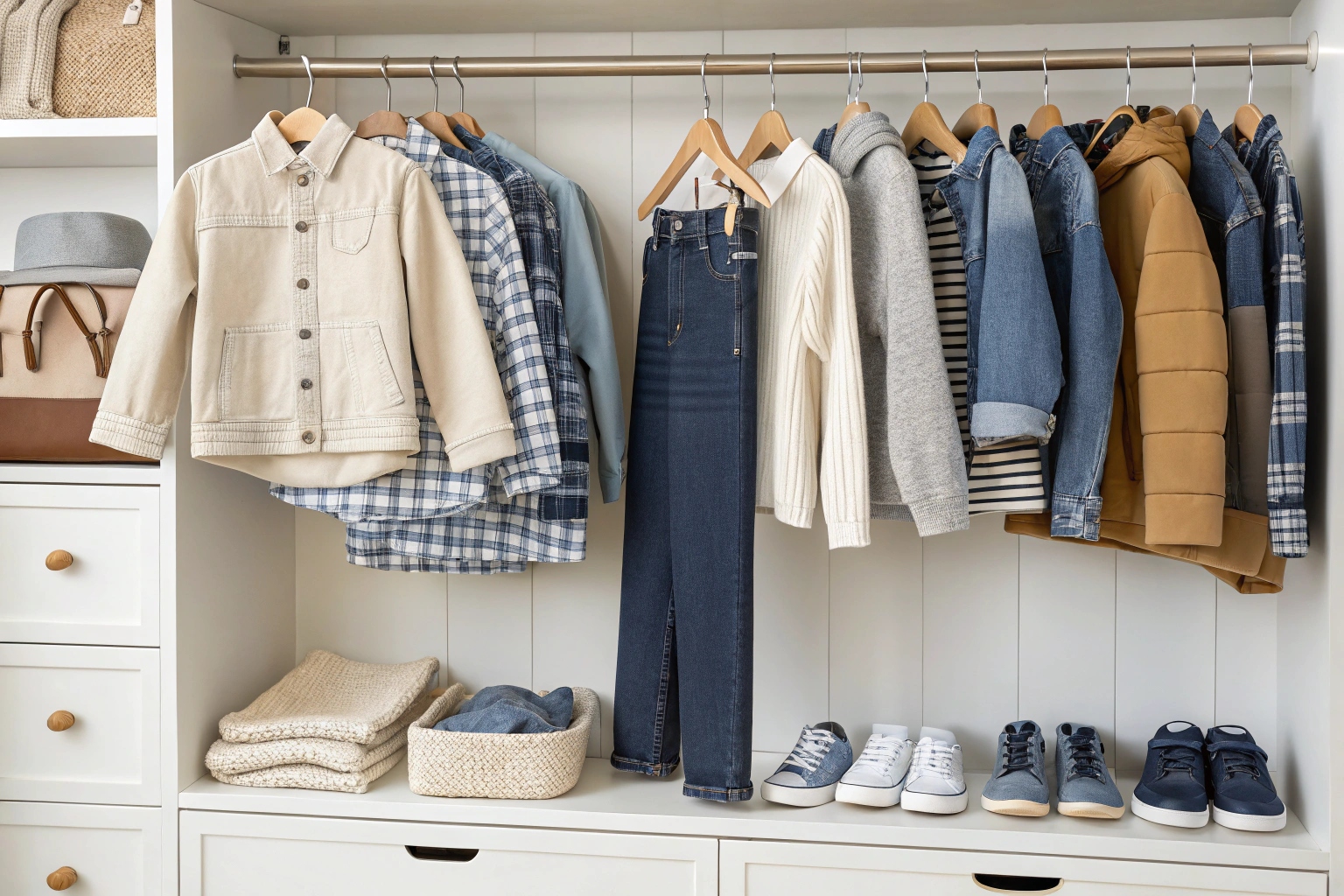In today’s fast-paced world, parents are always looking for ways to simplify their lives, and clothing is no exception. Capsule collections for kids have become an increasingly popular choice for parents seeking to make their child’s wardrobe more functional, stylish, and easy to manage. By focusing on versatile pieces that can be mixed and matched, capsule wardrobes help parents save time, reduce clutter, and ensure their children are always dressed in comfortable, fashionable outfits.
Capsule collections for kids offer simplicity and versatility by providing essential clothing pieces that can be easily mixed and matched. This approach not only makes dressing children easier but also promotes a more sustainable and practical way of shopping for kids' clothing.
In this article, we will explore what makes capsule collections for kids so popular, the rules and concepts behind them, and why they have become a go-to choice for modern parents.
What is the 3-3-3 rule for wardrobe?
The 3-3-3 rule is a guideline for creating a practical and versatile wardrobe that simplifies the process of getting dressed, particularly for parents with children. The rule suggests that you should have three categories of clothing in your wardrobe: tops, bottoms, and layers. For each category, you should aim for three pieces, giving you nine essential clothing items to work with.
The 3-3-3 rule focuses on building a small, functional wardrobe that provides flexibility and versatility. By sticking to a limited number of pieces in each category, parents can mix and match to create a variety of outfits for their kids without overstuffing their closets.
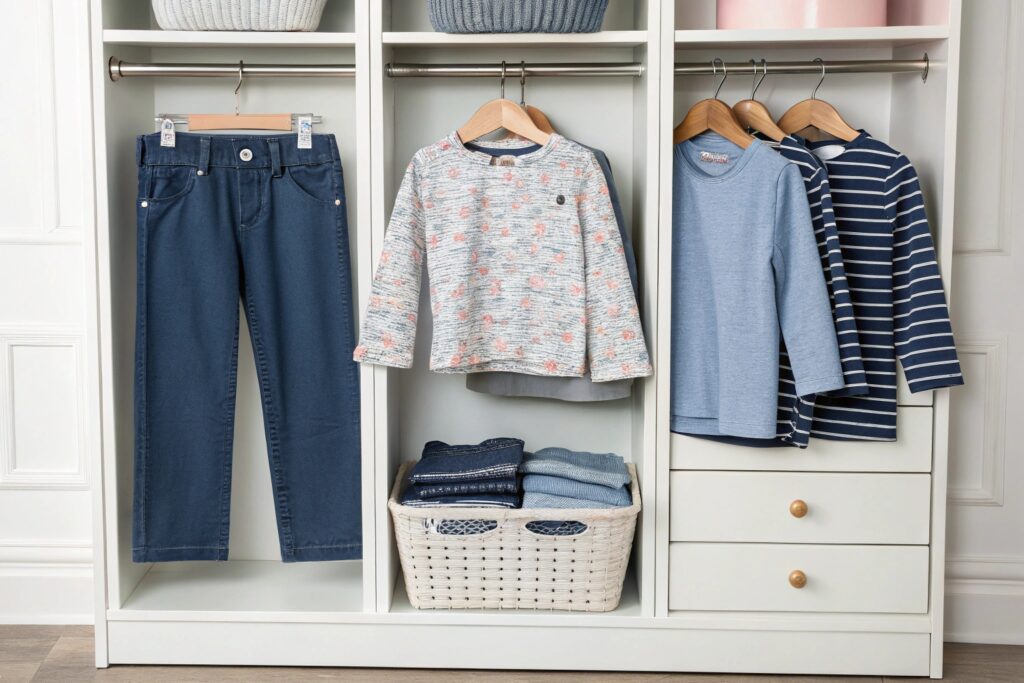
How the 3-3-3 Rule Works in a Kids’ Wardrobe
When applied to kids' clothing, the 3-3-3 rule typically consists of three tops, three bottoms, and three layers (like jackets or sweaters). This allows parents to create several outfit combinations using only a few pieces, making it easy to get dressed without too much fuss.
For example:
- Tops: 3 t-shirts, 3 long-sleeve shirts, 3 sweaters or hoodies
- Bottoms: 3 pairs of jeans or leggings, 3 pairs of shorts, 3 skirts
- Layers: 3 jackets or cardigans for various weather conditions
This limited selection of pieces offers enough variety for kids to wear different outfits throughout the week while ensuring that everything coordinates well together. The 3-3-3 rule is especially useful for parents who want to minimize clothing clutter while still ensuring their kids are dressed stylishly and comfortably.
Benefits of the 3-3-3 Rule for Kids' Wardrobe
The 3-3-3 rule helps parents streamline their kids' clothing choices, reducing decision fatigue and making it easier to get kids dressed every morning. With fewer options to choose from, parents can focus on quality over quantity, selecting durable and versatile pieces that can be worn in various combinations. It also encourages sustainability, as parents are less likely to overbuy or accumulate unnecessary items.
What is a capsule wardrobe for kids?
A capsule wardrobe for kids is a curated collection of essential, high-quality clothing items that can be easily mixed and matched. The idea behind a capsule wardrobe is to create a functional and stylish set of clothes that work well together and cover all of a child's needs. Instead of having an overflowing closet full of items that are rarely worn, a capsule wardrobe ensures that every piece serves a purpose and can be combined in multiple ways.
A capsule wardrobe for kids emphasizes simplicity, versatility, and quality. It provides parents with a practical, organized way to manage their child’s clothing and ensures that they always have something to wear without the clutter.
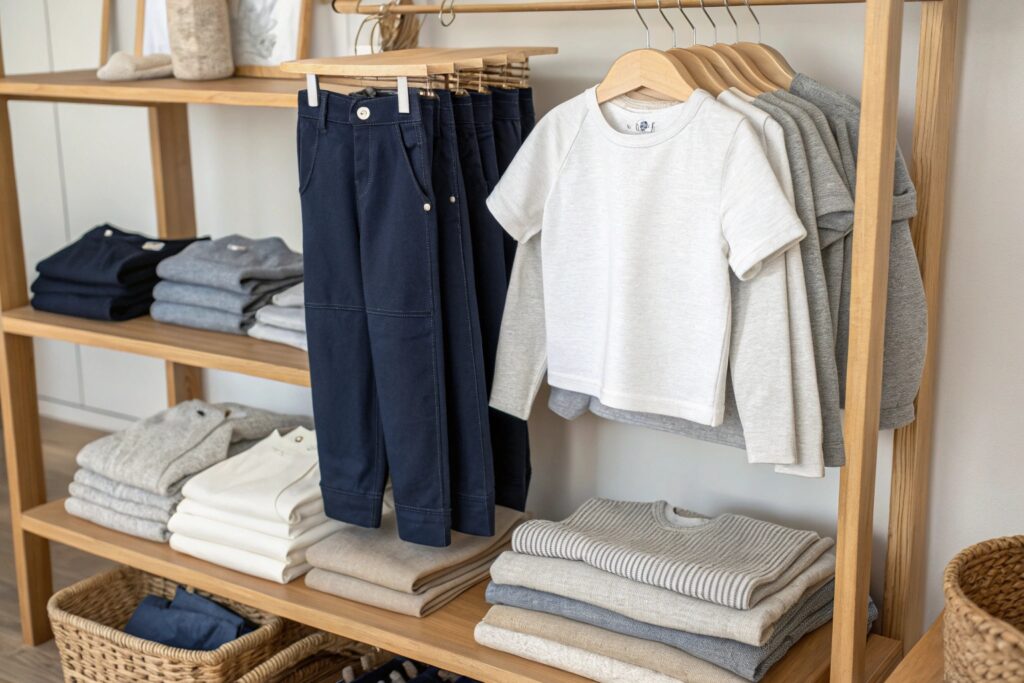
Essential Pieces in a Kids’ Capsule Wardrobe
A well-rounded kids' capsule wardrobe typically includes a selection of tops, bottoms, dresses, outerwear, shoes, and accessories that are versatile and easy to mix and match. Key pieces might include:
- Tops: T-shirts, long-sleeve shirts, sweaters
- Bottoms: Jeans, leggings, skirts
- Dresses: Versatile dresses that can be dressed up or down
- Outerwear: Jackets, coats, or cardigans
- Shoes: Comfortable sneakers, sandals, and boots
- Accessories: Hats, scarves, and backpacks
These pieces should be chosen with versatility in mind, ensuring that they can be styled in different ways for various occasions. A capsule wardrobe encourages parents to invest in higher-quality items that are durable and timeless, rather than fast fashion that may not hold up over time.
The Benefits of a Capsule Wardrobe for Kids
Capsule wardrobes help parents save time and money by eliminating the need for excessive shopping. With a limited number of clothing items that can be mixed and matched, parents can create multiple outfits without purchasing too many pieces. This approach is also more sustainable, as it reduces the consumption of clothing and encourages the use of durable, long-lasting items.
By focusing on quality, parents can ensure that their kids are always dressed in clothes that are comfortable, stylish, and versatile, making capsule wardrobes an appealing choice for modern families.
What is the rule of 5 in the capsule wardrobe?
The rule of 5 is a concept that can be applied to capsule wardrobes, particularly for kids. It suggests that, within a capsule wardrobe, parents should aim for five key pieces that can be mixed and matched to create various outfits. These pieces should cover all of a child’s basic clothing needs and should be versatile enough to work for different occasions.
The rule of 5 focuses on selecting a small number of key pieces that can be combined in multiple ways. This simple approach ensures that parents have a functional wardrobe for their kids without overloading the closet with unnecessary items.
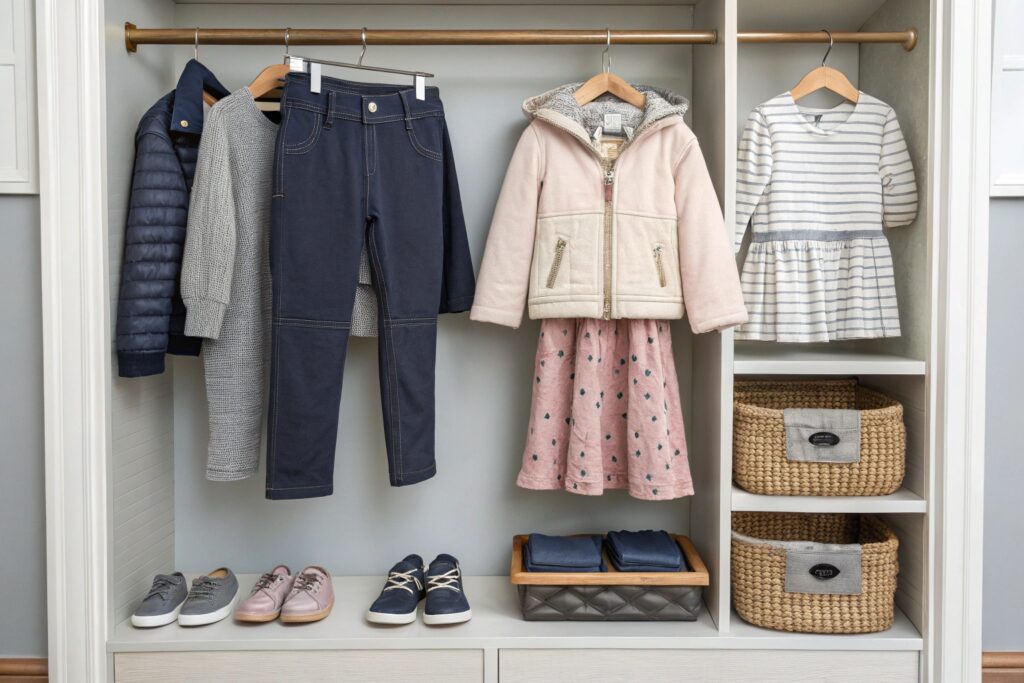
Key Pieces in the Rule of 5
The rule of 5 typically includes five essential clothing items that form the foundation of the capsule wardrobe. These items should be chosen for their versatility and practicality. For kids, the rule of 5 might include:
- A versatile pair of pants or leggings
- A comfortable, everyday t-shirt or top
- A jacket or cardigan for layering
- A pair of shoes that can be worn with various outfits
- A dress or skirt that can be dressed up or down
With these five key items, parents can create a variety of outfits by mixing and matching. The idea is to have a small number of high-quality, versatile pieces that serve the child’s everyday needs without requiring a lot of excess clothing.
Why the Rule of 5 Works
The rule of 5 works because it encourages parents to focus on what’s truly necessary for their kids’ wardrobes. By limiting the number of items, parents can avoid the temptation to buy excess clothing, ensuring that their child has everything they need without the clutter. This approach not only simplifies dressing but also promotes a more sustainable, minimalist lifestyle.
Why is clothing important for children?
Clothing plays an essential role in a child’s well-being, comfort, and development. Beyond protecting them from the elements, clothing can impact their physical comfort, emotional security, and even their confidence. As they grow, children’s clothing needs to support their physical development while allowing for ease of movement and self-expression.
Clothing for children is important because it helps protect them, supports their development, and provides comfort and confidence. Parents prioritize clothing that meets their child’s physical, emotional, and social needs.
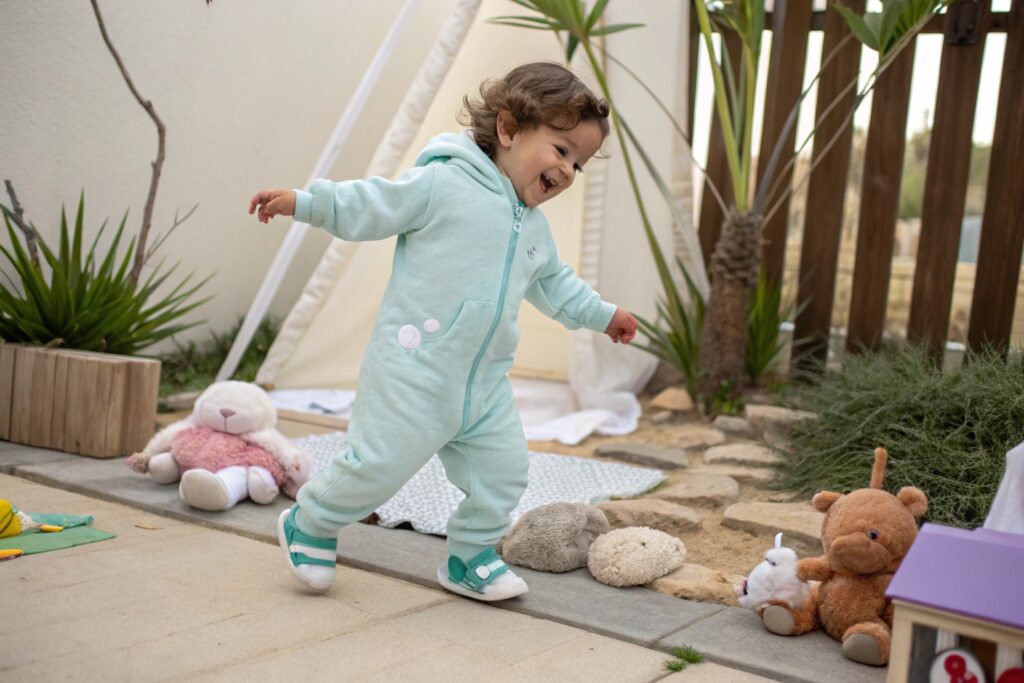
Protection and Comfort
The primary role of clothing is to protect the child from environmental elements like cold, heat, and rain. In addition, clothes need to be comfortable, allowing children to move freely and engage in activities without restrictions. Soft, breathable fabrics are essential for providing comfort and preventing irritation or discomfort.
Children’s clothing should also be functional, with easy-to-use fasteners, stretchable fabrics, and adjustable features that accommodate growth and movement. This ensures that children are comfortable and happy in their clothes, which contributes to their overall well-being.
Social and Emotional Development
Clothing also plays a role in a child’s social and emotional development. As children grow, they begin to express their personality and preferences through their clothing. Allowing kids to choose their clothes and wear items they feel good in can help build confidence and a sense of independence.
In addition, clothing that reflects social norms and expectations can help children feel more included in social activities, as they learn how to dress appropriately for different occasions.
Conclusion
Capsule collections for kids are becoming increasingly popular among parents looking to simplify their child’s wardrobe while still providing versatility, comfort, and style. By focusing on essential, high-quality pieces that can be easily mixed and matched, parents can create a functional, sustainable wardrobe that makes dressing children easier and more efficient. Whether following the 3-3-3 rule, adopting the rule of 5, or creating a capsule wardrobe, this minimalist approach to kids' clothing is not only practical but also helps parents save time, money, and space.

